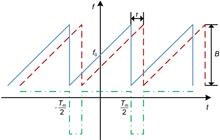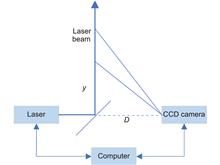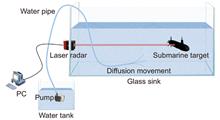 View fulltext
View fulltext
Phase diversity is one of the commonly used image post-reconstruction methods. In order to improve the robustness of phase diversity for solar image reconstruction, this paper proposes an improved phase diversity method based on the low-rank prior, i.e., the nuclear norm regularization of the image is introduced into the phase diversity model, and the image sub-model and the phase sub-model are solved by the half-quadratic splitting method and BFGS respectively. Reconstruction experiments and analysis are carried out on the simulated degraded focused and defocused solar images. Compared with the classical phase diversity based on Tikhonov regularization, the phase diversity based on low-rank prior can improve the accuracy of wavefront phase estimation and the quality of reconstructed images in terms of subjective visual effects and objective indexes in both the noise-free and noise-included cases.
The frequency-modulated continuous wave laser interferometry is widely used in the field of precision measurement. Aiming at its high-precision displacement demodulation problem, this paper applies the centroid method to the demodulation of its beat signal, proposes a phase demodulation algorithm based on the centroid peak-seeking method, and carries out experiments and analysis. Based on the smooth filtering and peak clipping of the intercepted beat signal, the proposed algorithm obtains the centroid of the beat signal through the centroid coordinate formula. The abscissa of the centroid is the peak position. Finally, the phase discrimination algorithm demodulates the displacement. In the simulation, the SNR is set to 15 dB, the phase error of the algorithm is 0.016 rad, and the displacement error is 2.04 nm. A frequency-modulated continuous wave laser interference displacement measurement system was built for experimental verification. The experimental results show that when the fixed distance is 44 mm, the standard deviation of random displacement error is 2.18 nm. Compared with the conventional zero crossing detection method, the measurement error of the algorithm is reduced by 49%, the resolution is improved, and the algorithm has broad application prospects.
A side-scatter lidar is known to have evident advantages over other types of lidar in atmosphere detection. However, the signal of the side-scatter lidar may suffer from the noise as all other lidars. It is noted that the original signal of the side-scatter lidar is an image captured by a CCD camera. Therefore, denoising the side-scatter lidar signal may need more efforts than ordinary radar signals. In the paper, a denoising algorithm based on convolution neutral network is proposed for the side-scatter lidar signal. We combine the residual learning with batch standardization in the network. Further, attention mechanism and activation function in the network are optimized in order to improve the learning efficiency and the network output performance. Using the proposed algorithm, we successfully identify the noise and separate the noise from the simulated lidar signal. The signal-to-noise ratio is hence increased. Simulation results show that the peak signal-to-noise ratio is increased by over 5 dB using the proposed denoising algorithm. The relative error of signal is reduced to 9.62%. The proposed denoising algorithm based on the convolution neutral network is shown to be efficient for improving the side-scatter lidar signal, compared with the possible denoising algorithms based on wavelet transform and Wiener filtering.
Three-dimensional point cloud reconstruction of underwater targets has important applications in underwater exploration and obstacle avoidance of underwater unmanned vehicles. In this paper, the underwater target detection experiment is carried out by simulating the temperature and salinity water turbulence in the laboratory, and the influence of temperature difference and salinity difference on the laser point cloud three-dimensional reconstruction effect of underwater submarines, gliders and anchor mines are studied, and the error analysis of the reconstructed 3D point cloud data is carried out. The results show that in the process of underwater target 3D point cloud reconstruction, with the enhancement of water temperature turbulence and salinity turbulence intensity, the effective points of the reconstructed point cloud data decrease significantly, and the mean error increased significantly. The research results have a certain reference value for the development of underwater three-dimensional point cloud reconstruction system.
The Solar-blind UV detection has wide application scenarios and unique market values in the civil and military fields, such as space security communication, ozone hole detection, missile attack warning and so on. Gallium oxide (Ga2O3) has an extremely wide band gap (4.4-5.3 eV), almost covering the entire solar-blind UV region, and is considered as one of the most promising materials for the preparation of solar-blind UV photodetectors. Compared with single crystal or epitaxy materials, amorphous gallium oxide (a-Ga2O3) has a lower deposition temperature, a relatively simple preparation process, and a much wider range of applicable substrates. Therefore, it has become a new research hot spot in the field of the Ga2O3 solar-blind UV detection in most recent years. In this paper, the basic characteristics and most common preparation methods of a-Ga2O3 are introduced firstly, and then the research progress and present situations of the a-Ga2O3-based solar-blind UV photodetector are introduced in details from the perspective of device structures. At present, a-Ga2O3 based solar-blind UV photodetectors are mainly divided into MSM, junction, TFT and array types. By the optimization of device structures, the photodetection performance has been significantly improved. MSM device is the most widely used because of its simple structure and high responsivity. By constructing Schottky junction or heterojunction, the junction-type devices own the characteristics of fast response speed, low dark current, and self-power supply. TFT devices can suppress the dark current, amplify the gain and improve the recovery speed by applying gate voltage. Array-type devices can be used for large-area imaging. Finally, the future development trends of the a-Ga2O3 solar-blind UV photodetector are summarized.
Multiple object tracking (MOT) is an important task in computer vision. Most of the MOT methods improve object detection and data association, usually ignoring the correlation between different frames. They don’t make good use of the temporal information in the video, which makes the tracking performance significantly degraded in motion blur, occlusion, and small target scenes. In order to solve these problems, this paper proposes a multiple object tracking method with the aligned spatial-temporal feature. First, the convolutional gated recurrent unit (ConvGRU) is introduced to encode the spatial-temporal information of the object in the video; By considering the whole history frame sequence, this structure effectively extracts the spatial-temporal information to enhance the feature representation. Then, the feature alignment module is designed to ensure the time consistency between the historical frame information and the current frame information to reduce the false detection rate. Finally, this paper tests on MOT17 and MOT20 datasets, and multiple object tracking accuracy (MOTA) values are 74.2 and 67.4, respectively, which is increased by 0.5 and 5.6 compared with the baseline FairMOT method. Our identification F1 score (IDF1) values are 73.9 and 70.6, respectively, which are increased by 1.6 and 3.3 compared with the baseline FairMOT method. In addition, the qualitative and quantitative experimental results show that the overall tracking performance of this method is better than that of most of the current advanced methods.
As a kind of underwater active sonar equipment, forward-looking sonar is often used to collect underwater image data. However, it will be affected by underwater noise, which leads to the degradation of image quality. Due to this situation, a forward-looking sonar image denoising method is proposed based on dense residuals and a dual-channel attention mechanism network. Firstly, the two-channel attention mechanism is adopted to extract the channel information of the sonar image, collect the global information of the sonar image, and output the noise map of the sonar image. Based on the noise image and sonar image, the dense residual block fully learns the feature information at different scales and outputs a clean sonar image after multiple learning and information transfer. Because of the forward-looking sonar image and its noise characteristics, the forward-looking sonar image is simulated and the multiplicative noise of Rayleigh distribution and the additive noise of Gaussian distribution are added to generate a simulation dataset for network training and performance evaluation. Experimental results on the simulated data set and real data set show that the proposed method can effectively remove the noise and retain image details.
Surface enhanced Raman spectroscopy (SERS) is a kind of molecular spectrum, which has the characteristics of rapidity, high sensitivity and fingerprint recognition, and has important applications in analytical chemistry, biomedicine and other fields. However, some detection molecules in the solution sample are difficult to be adsorbed by the SERS substrate, resulting in difficulty in enhancing the Raman signal of molecular. To this end, this paper proposes a core-shell structure (AuNRs@ZIF-8) of ZIF-8 material coated gold nanorods (AuNRs) to achieve Raman signal enhancement. Both the surface plasmon enhancement characteristics of the gold nanoparticles and the adsorption properties of ZIF-8, a porous MOFs material, can be used to realize highly sensitive Raman detection of the solution samples. We first prepare the well-homogeneous AuNRs by seed crystallization method, then modify them with polyvinylpyrrolidone (PVP), and finally add the metal-organic framework ZIF-8 precursor to obtain the AuNRs@ZIF-8 Core-shell nanostructures. The structure has high sensitivity to the SERS detection of rhodamine (R6G), the detection limit can be as low as 10?9 M, and the linear relationship and homogeneity are good. In addition, we further confirm the formation of the core-shell nanostructures and effective adsorption of the target molecules by testing the UV-Vis absorption spectra of the structure before and after R6G absorption.
Optical skyrmions provide a new idea and approach to endow structured light and spatial-temporal light with topological properties. In this paper, the longitudinal and transversal components of the focused light field are decoupled and can be controlled independently by modulating the polarizations and phases of two pairs of counter-propagating incident cylindrical vector beams under 4π focal configuration. Under this condition, Néel-type and Bloch-type optical skyrmions formed by electromagnetic field vectors are constructed in the focal plane. When one pair of the incident beams is radially polarized with a phase difference of π and the other pair is radially polarized in phase, a Néel-type optical skyrmion formed by electric field vectors can be constructed in the focal plane of the 4π focal system. The corresponding focal magnetic field is purely azimuthally polarized. If we substitute the other pair of the incident beams with azimuthally polarized beams, Bloch-type optical skyrmions formed by electromagnetic field vectors can be constructed in the focal plane, where the one formed by magnetic field vectors has a π/2 phase lead compared with the that formed by electric field vectors. This work provides a theoretical basis for further research on the interactions between matter and optical skyrmions formed by electromagnetic field vectors at micro and nano scales in free space.














